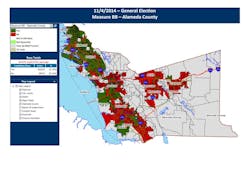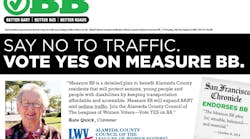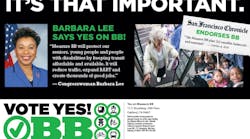For the residents of Alameda County, California, supporting taxes for transportation initiatives isn’t a new concept.
In 1986, the county was one of the first to pass a ballot initiative to fund transportation projects. In 2000, the commission went back to voters to fund a 20-year plan for transportation improvements. It also passed.
The projects went so well, most were completed by 2010, so voters were again asked in 2012 to support new initiatives. But unlike the past efforts, the referendum failed.
And it failed in a high turnout presidential election, which are supposed to favor such efforts. This brought some major concern for local transportation leaders.
“When we place something on the ballot, there’s a 66.67 percent threshold to pass a ballot measure and in a presidential election, we came exceedingly close with 66.53 percent, but that’s still shy of the two-thirds requirement despite all the hard work put into the plan by agency members, despite the extensive outreach,” said Tess Lengyel, deputy director of planning and policy for Alameda County Transportation Commission (ACTC). “We recognized afterwards there were some key things people reacted to in that 2012 measure, but it’s hard to say what kept it under that edge.”
After the loss, transportation and campaign planners combed over the failed effort and the plan to see what went wrong. Then they went back to the voters in the 2014 November General Election to ask for support for the plan, despite an expected low turnout due to a barely contested gubernatorial race being the biggest draw on the ballot.
But this time, the initiative — known as Measure BB — was successful. Even with lower turnout, 70.76 percent of voters came out in favor of the plan.
Filling a need in Alameda
Located in the East Bay area of the San Francisco Bay metropolitan region, Alameda County is 821 square miles, consisting of urbanized areas like Oakland and Berkeley, to midsized communities, farmland and wine country. Interstates and highways serve as the prime mode of transportation in eastern areas of the county, while other areas rely on 22 Bay Area Rapid Transit (BART) stations, AC Transit bus service, ferry service and other smaller systems. Capital Corridor and Amtrak lines serve the region, while major freight lines for Union Pacific and BNSF serve the county, which also is home to the Port of Oakland — one of the largest ports in the U.S.
About 30 percent of every single commute in the bay area touches our county,” Lengyel said. “This is a very centralized place.”
Lengyel said in the next 20 years, the county of 1.5 million people is projected to see its population rise 30 percent. And the transportation needs have to meet a diverse area to serve everyone from farmers to biotech centers while also meeting California’s stringent requirements to reduce greenhouse gas emissions.
Measure BB asked voters to approve renewing the 0.5 percent sales tax passed in 2000, adding another 0.5 percent tax on top of it and using the funds to invest in $7.8 billion in transportation needs outlined in the ACTC 30-year transportation needs plan.
“We know there’s no silver bullet for transportation,” Lengyel said. “We need to have all modes funded and working well.”
Lengyel said the commission presented this information during the 2012 push, but it still didn’t curry favor with enough of the electorate to pass the measure.
“We came very close and by LA they had something similar on the same ballot and it lost despite getting over 60 percent as well,” Lengyel said. “The two areas that are kind of known as being able to pass these types of measures weren’t able to and that sent shockwaves throughout the state.
“Was it even possible to do what we wanted to do?”
Same Need, New Message
After ACTC got the measure on the ballot for the fall 2014 election, the agency was barred from advocating a position on Measure BB, but it could educate the community about what projects were planned. It had put the information out in 2012 as well, but this time, Lengyel said they simplified the message.
“I think the mistake that agencies — every agency — in many local elections with these kinds of initiatives, a lot of people focus on the last three months,” said Tom Clifford, principal for CliffordMoss, which led the outreach campaign for Measure BB. “But the story of the measure is almost never told in the last three months. The real devil to the details is the two years really leading up to this point.”
One of the fundamental perceptions of a campaign is that it’s about the voters, not the people pushing the issue, but Clifford said many campaigns seem to focus on themselves, not the people. When sending information to the voters, it’s important to present the campaign to the people to tell them why it’s important to them. In an area like Alameda County, the message had to be intermodal because voters in the rural areas don’t care as much about transit as they would about major arterial routes, while urban residents care more about transit and bicycle infrastructure.
“One thing we really paid attention to was how to regionalize the messaging and operations,” he said. “By regionalizing the issues we could educate residents about the issues they cared about.”
Coalition building also made the plan successful, Clifford said, because it created ownership for community groups. Those involved with the planning process went out to push a plan not just developed by ACTC, but one they helped build. It became a plan created by environmental groups, business groups, unions and other organization.
Beverly Greene, director of legislative affairs and community relations for AC Transit who participated in the planning process for the transportation plan, said the agency had a lot of discussions with stakeholders and riders to prepare for planning. Input was solicited from the general manager’s newsletter and other outreach methods.
“There has been a lot of discussion about the importance of AC Transit. It’s really the workhorse for the public transit agencies in the East Bay and people recognize how important AC Transit is to the community,” she said. “There has been many discussions with policy makers and community advocates to try and convey how important it is for AC Transit to be funded.
“Additionally, during the recessionary period in 2010, AC Transit had just had service cuts that were just devastating, so it was recognized how important AC Transit was.”
Fighting Pushback
Like all ballot measures, opposition groups formed against Measure BB. The two groups in Alameda County, one consisted of anti-tax people, while the second group consisted of environmental-focused residents who said they didn’t think the plan did enough to focus on those concerns.
Clifford said it’s important to not spend too much time rebutting the opposition, but to move forward with your message aggressively.
“The way we dealt with them and the way you deal with opposition to any campaign is you have to monitor their actions,” he said. “You can’t let them change the way you put your message out.”
Lengyel said opposition can grow from confusion. She was invited to talk with people from one area of the county with concerns Measure BB was going to increase vehicle miles traveled and increase greenhouse gas emissions, and they were trying to confuse the issue. She said issues like that come from someone misreading the materials, so it’s important to clarify the information and put it to the public for them to see.
Despite the broad swath of supporters in 2012, there were still a few key organizations, like the Sierra Club who didn’t back the measure. Without members of those organizations getting information to support the measure, it may have swayed votes.
“The Sierra Club is something voters look for to provide information,” Lengyel said.
When crafting the 2012 transportation plan, Lengyel said ACTC brought in community members and local organizations to provide input to shape the future. Once the plan failed, they weren’t discouraged by the results.
“This whole set of people that put in the 10,000 hours of work on this 2012 plan came right back,” she said. “They’re the ones who invested all their time and said ‘this is a good plan, we worked really hard on this.’
“There were a lot of supportive and involved community members and local groups who developed this plan who said ‘hey, this is good, so let’s keep it going.’”
Clifford said when embarking on a referendum, first and foremost, an agency must develop a plan and its needs, then get research on what voters care about, then in a Venn Diagram, find the sweet spot that intersect.
“That’s where you spend your time,” he said. “What the voters care about and what the agency needs to do for the public benefit in campaign regionalization.”
Delving into the polls, Clifford said low turnout doesn’t mean a measure will fail despite a lack of motivated, young progressive voters. Turnout can be combatted with targeting the message towards likely voters.
“We took a high end number of possible voters and ran an algorithm of their likelihood to vote and decided to run the campaign targeted just at persons likely to support us. A hard ‘yes’ was already with us and a hard ‘no’ was a group who we were most likely never going to sway.
“We were focused on that soft middle and that’s where we were targeting our pieces.”
David Armijo, general manager for AC Transit said unlike the 2012 campaign, he didn’t notice the same amount of opposition during the BB campaign.
“My real sense of the success this time compared to last time is because they had a much better campaign,” Armijo said. “There were a lot of visibility in the streets, with a lot of flyers and we probably had the biggest point of a lot of crossover with many in the city council race supporting Measure BB and putting it on their campaign literature.
“We didn’t have that two years ago.”
Power in Numbers
The field campaign raised $1.5 million, made about 120,000 phone calls to voters, knocked on 15,000-20,000 doors across the region and in the last five days of the campaign, volunteers went out and put 80,000 door hangers out — each with their own regionalized message.
Even though the election had the lowest voter turnout since 2002, Clifford said there was a significant drop in the amount of people who under voted. Of those who cast a vote in Gov. Jerry Brown’s re-election race, only 7 percent didn’t vote for BB. In the failed 2012 push, 11 percent under voted the measure and in the successful 2000 campaign, 15 percent under voted that measure.
“People support what they helped create,” he said. “I’d really shop that message to them from the moment they start to build consensus and to build as much consensus as possible.”
“From the public agency side, you know, we had to really bring all of these people to the table because they’re part of the solution. They work in the community and we know we needed to engage the community,” Lengyel said. “So I think the two major things are one, you have to bring people to the table and it takes time, it takes an investment and it takes being flexible to work with all these very different grounds and bring people around together to support.
“And that’s the second piece. We have a very diverse county that has everything from wineries to the Port of Oakland. We needed to put into the plan investments to those different areas…and you have to be able to take care of the whole county. The package has to be supported by the entire county; it has to have support at the top level and the local politicians. They endorsed it, they welcomed it and that’s how you are able to bring people together.”
Clifford said going into a tough campaign it’s important to have a robust field operation in place to go knock on doors and make phone calls leading up to the election. In a large area like Alamenda County, it’s really important to start that process very early.
“You almost have to create a reason that before they go out you can almost have a spring training for the campaign,” he said.
For Bay Area transit agencies, educating the public without advocating for the referendum meant being careful with how information was presented.
Donna Lee principle planner for BART said ACTC came to the agency in June asking to put flyers in the Alameda County stations with information regarding the vote. Once reviewed by the legal department, the flyers were allowed and more than 7,000 were placed into stations.
There was another group asking to bring in their flyers, but after vetting the information, Lee said the agency couldn’t allow them inside stations.
“They have to be purely educational,” she said. “They can’t advocate for people to vote one way or another.”
Lee said there was only one person — who wasn’t even a county resident — who raised concerns about the flyers.
Clifford said the campaign invested in a mix of television, Web, radio and print advertisements for the campaign, but a retrospective showed him he probably should have cut back on his television advertising budget by 20-30 percent and instead put the investment into mailers, given the regionalized messages of the campaign and its effectiveness.
Lee said if another similar measure came about BART would consider making its own educational flyers to put in stations because outside agency flyers can be confusing, especially for other groups then asking to put out their own flyers for events unrelated to BART.
Armijo said it was an important for the agency to educate the community because the parcel tax goes back to voters in two years, so people will want to know what they’ve gotten for their money.
He recommended getting a broad base coalition and focus group feedback when planning for a big measure in order to build support.
“Find out what people think about the plan, why they like it, why they don’t like and you better be willing to change the plan” he said. “You better be willing to listen to people who don’t support you and you need to understand why they don’t support what you’re advocating.”

Joe Petrie | Associate Editor
I came to Mass Transit in 2013 after spending seven years on the daily newsbeat in southeastern Wisconsin.
Based in Milwaukee, I worked as a daily newspaper reporter with the Waukesha Freeman from 2006-2011, where I covered education, county and state government. I went on to cover courts for Patch.com, where I was the main courts reporter in the Metro Milwaukee cluster of websites.
I’ve won multiple awards during the course of my career and have covered some of the biggest political events in the past decade and have appeared on national programs.
Having covered local government and social issues, I discovered the importance of transit and the impact it can have on communities when implemented, supported and funded.







